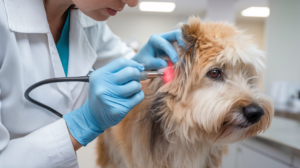Maintaining good ear health in pets is essential for their overall well-being. Pets, particularly dogs and cats, are prone to various ear problems that can range from mild discomfort to serious health concerns. Understanding the common ear issues that can affect pets, such as infections and infestations by parasites like ear mites, is crucial for pet owners. Recognizing the signs early on can prevent long-term damage and ensure that pets remain happy and healthy.
One of the primary challenges for pet owners is differentiating between ear mites and ear infections. While they may present with similar symptoms, such as scratching, head shaking, and discharge, the causes and treatments are quite distinct. Properly identifying the issue is key to applying the right treatment plan and ensuring effective recovery. A misdiagnosis may result in poor therapy, which might worsen the problem and prolong the agony. This guide aims to shed light on the differences between ear mites and ear infections to help pet owners better understand how to care for their pets’ ears.
What Are Ear Mites?
Ear mites are tiny, highly contagious parasites that live on the surface of the skin in the ear canal. These tiny creatures feed on the wax and oils in a pet’s ears, causing significant irritation and discomfort. Although they are more common in cats, dogs can also be affected by these parasites. Ear mites are most frequently seen in outdoor pets or those that come into contact with other animals that may be infested.

Symptoms
- Intense itching and scratching: Pets with ear mites often exhibit severe scratching around the ears and head.
- Dark, crumbly discharge: This discharge, which resembles coffee grounds, is a hallmark sign of ear mite infestation.
- Head shaking and ear rubbing: The irritation caused by ear mites leads to frequent head shaking and rubbing of the ears against surfaces.
Causes and Transmission
Ear mites are usually spread through direct contact with an infected animal. Pets can acquire ear mites by playing or being near other affected pets. This is especially common in multi-pet households, shelters, or outdoor environments where animals interact with each other.
What Are Ear Infections?
Ear infections in pets are common ailments that involve inflammation of the ear canal, which can be caused by bacteria, fungi, or yeast. These infections can affect the outer, middle, or inner ear, with outer ear infections (otitis externa) being the most prevalent. Ear infections can lead to significant pain and, if left untreated, may progress to more severe conditions affecting the pet’s hearing and balance.

Symptoms
- Redness and inflammation: The ear canal of your feline may appear swollen and red.
- Unpleasant odor: Ear infections often produce a noticeable, unpleasant smell.
- Discharge that may be yellow or brown: The type of discharge can vary depending on the type of infection.
- Pain and sensitivity to touch: Pets may react when their ears are touched, showing signs of discomfort or even yelping.
Common Causes
Ear infections are often triggered by a combination of factors. Moisture trapped in the ears after swimming or bathing can create an environment conducive to bacterial or yeast growth. Allergies, such as those related to food or environmental triggers, can also contribute to inflammation and infection. Additionally, foreign bodies like grass seeds or excessive earwax buildup can block the ear canal, leading to an infection. Ensuring regular ear cleaning and prompt attention to any signs of discomfort can help mitigate these risks.
Key Differences Between Ear Mites and Ear Infections
When it comes to ear problems in pets, two common issues often confuse pet owners: ear mites and ear infections. Both conditions can cause discomfort for your pet, but they have distinct causes, symptoms, and treatments. Understanding the differences between ear mites and ear infections is essential for getting your pet the right care.
Visual Differences
One of the easiest ways to distinguish between ear mites and ear infections is by looking at the appearance of the discharge. Ear mites typically cause a dark, crumbly discharge in the ear, often resembling coffee grounds. This is due to the mites feeding on ear wax and skin oils. On the other hand, an ear infection generally produces a thick, yellow, or greenish discharge, which may have a foul odor. The severity of redness and inflammation also differs: while ear mites cause irritation, ear infections usually result in more significant swelling and redness, particularly if the infection is bacterial or fungal. Infections often look much more inflamed compared to the milder irritation caused by ear mites.
Behavioral Indicators
Behaviorally, there are key differences in how pets react to ear mites and ear infections. If your pet has ear mites, you may notice excessive scratching, particularly around the ears, or even shaking of the head. However, ear mites typically cause itching in both ears simultaneously, leading to more constant behavior like rubbing the face against furniture. Ear infections, though, may cause similar scratching but often appear with more localized signs of distress. Pets with ear infections might tilt their head to one side, showing discomfort in one ear. They might also exhibit signs of pain when you touch their ears, or they may even avoid you touching the affected area altogether.
Diagnosis Process
To accurately diagnose ear mites or an ear infection, a veterinarian will use specific tools and techniques. One of the most common diagnostic tools is an otoscope, which allows the vet to closely examine the inner ear for any signs of mites or infection. If ear mites are suspected, the vet may take a sample of the discharge to look under a microscope for the presence of mites, eggs, or larvae. In cases of suspected ear infections, a vet may take a culture or a sample of the discharge to identify whether bacteria, yeast, or fungi are the culprits. This helps ensure that the appropriate treatment is prescribed, as the treatments for ear mites and ear infections differ significantly.

By understanding the differences in visual signs, behavioral responses, and diagnostic procedures, pet owners can be better prepared to seek prompt veterinary care and ensure their pet’s ear health.
Diagnosis and Veterinary Examination
When it comes to ear problems in pets, the importance of a professional diagnosis cannot be overstated. While pet owners might notice symptoms like scratching or head shaking, it’s crucial to differentiate between ear mites and ear infections, as they require different treatments. A veterinary examination allows for an accurate diagnosis, helping avoid unnecessary or incorrect treatments that could worsen the issue. Misdiagnosing or ignoring ear problems can lead to complications, so it’s always best to consult with a vet if your pet is showing signs of discomfort.
Veterinarians use various tools and techniques to identify the cause of ear issues. One of the most common tools is an otoscope, a device that allows the vet to look deep into the ear canal. If ear mites are suspected, the vet will often take an ear swab and examine it under a microscope for signs of the tiny parasites. For ear infections, the vet may collect samples of the discharge to determine whether it’s bacterial, fungal, or yeast-related. These diagnostic methods ensure that your pet receives the correct treatment tailored to their specific condition.
Treatment Options
Ear Mites
Treating ear mites typically involves topical treatments, such as ear drops or prescription medications, to kill the mites and soothe the irritation. These treatments are applied directly into the ear canal and may need to be repeated over several days to ensure all mites are eradicated. Additionally, it’s essential to clean both ears thoroughly to remove any discharge or debris that may harbor more mites or cause further irritation. A vet may recommend a specific ear-cleaning solution, which should be used according to their instructions. Consistent cleaning and medication are crucial to fully resolving the infestation and preventing reinfestation.
Ear Infections
Ear infections are treated based on the underlying cause—whether bacterial, fungal, or yeast-related. For bacterial infections, antibiotics are typically prescribed, while antifungal treatments are used for fungal or yeast infections. In some cases, a vet might recommend both, especially if the infection is mixed. In addition to medication, cleaning the ears is important to remove excess wax or debris, which can further aggravate the condition. Regular maintenance, such as gently wiping the ears with a vet-recommended ear cleaner, can help keep your pet’s ears in good condition and prevent future infections. It’s important to follow the vet’s guidelines on both medication and cleaning to ensure the infection clears up completely.
Preventative Care
Prevention is always better than cure, and there are several steps pet owners can take to maintain ear health and avoid recurrence. Regular ear checks, especially for pets with long or floppy ears, can help catch issues early before they become more serious. Keeping your pet’s ears clean and dry is key, particularly after baths or swimming. Use a veterinarian-approved ear cleaner to gently remove any debris, and never insert anything into the ear canal that could damage the sensitive tissue. Lastly, maintaining a healthy environment, including flea control, can help prevent ear mites from returning.
When to Seek Immediate Veterinary Help
In some cases, ear problems can escalate quickly, and it’s important to seek immediate veterinary help. If your pet is experiencing severe pain, or if you notice signs such as continuous ear bleeding, swelling, or a foul-smelling discharge, these are signs that urgent care is needed. An untreated ear problem can lead to serious complications, including chronic infections, hearing loss, or damage to the ear canal. Additionally, if the ear issue seems to be spreading to other parts of the body, or if your pet’s behavior dramatically changes due to discomfort, a quick veterinary visit is essential to prevent further harm.
Conclusion
Early detection and proper diagnosis are critical when it comes to ear problems in pets. Whether it’s ear mites or an ear infection, addressing the issue promptly with the correct treatment can prevent further complications and help your pet feel better faster. Regular ear check-ups and hygiene practices, such as routine cleaning and keeping your pet’s ears dry, are essential for maintaining ear health. By staying vigilant and seeking professional care when needed, you can ensure your pet enjoys clear, comfortable ears for years to come.
(FAQs)
How can I tell if my pet has ear mites or an ear infection?
Ear mites cause dark, crumbly discharge and itching, while ear infections produce thick, yellow, or green discharge, swelling, and redness.
What should I do if my pet scratches its ears constantly?
Schedule a vet visit to diagnose the cause, whether it’s ear mites, an infection, or allergies.
Are ear mites contagious to other pets?
Yes, ear mites are highly contagious, especially among pets in close contact.
How are ear infections treated?
Ear infections are treated with antibiotics or antifungals, and ear cleaning is done using a vet-approved solution.
How often should I clean my pet’s ears?
Pets with floppy ears may need cleaning every 1-2 weeks, while others may need it monthly. Always use a vet-approved cleaner.
Can ear problems cause hearing loss?
Yes, untreated ear problems can lead to hearing loss if they cause damage to the ear canal or eardrum.
What are the signs that my pet’s ear problem is serious?
Signs include severe pain, constant head shaking, swelling, foul odor, or bleeding, requiring immediate vet care.
Are there any ways to prevent ear mites and infections?
Regular ear checks, cleaning, and keeping ears dry can help prevent ear mites and infections.
